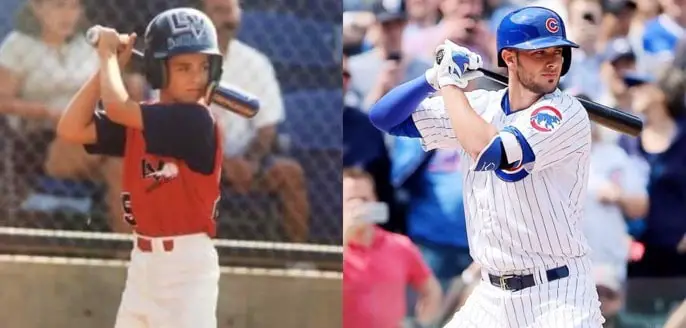
Kris Bryant’s (Sort of) Unchanged Swing and How He Almost Became a Pitcher
Kyle Schwarber has returned to a more “squatty” swing in an effort to get back to a simpler, more aggressive plate approach. My piece was inspired by one from the Tribune‘s Mark Gonzales, who included a brief quote from Kris Bryant that I filed away for later use.
“I’ve been hitting the same way since I was 8,” Bryant told Gonzales. “I don’t believe in changing too much in my swing, because up to this point it’s worked for me.”
As you can see from the featured image, Bryant’s current setup — hands high, bat parallel to ground, bears a striking resemblance to the one he employed as an 11-year-old. We’ll just have to take him at his word that it had been that way for at least three years.
And it makes sense that things would have stayed somewhat the same, since Bryant’s had the same swing coach his entire life. Mike Bryant has been crafting his son’s mechanics since the time he could lift a bat, which has allowed the former MVP to maintain greater consistency that you find in most hitters. There have, however, been some pretty significant changes over the years.
Most of those changes are subtle, like adjusting the vertical attack angle of the bat through thousands of offseason swings using a Zepp Analytics system. The biggest change, however, is so obvious that you can see it despite the way the pictures above are cropped. Here, I’ll show you again so you don’t have to scroll up and lose your spot.

Can you see it? He much more upright with a narrower stance in the earlier picture, a sharp contrast to the wider squat we’ve seen during his professional career. I know you can’t see all of that above, but it’s easy enough to discern just the same. For a little more context, take a look at the grainy video below from Bryant’s junior year at Bonanza High School* in Las Vegas.
He’s standing pretty much straight up in with a slightly open stance, then steps into his swing with a two-foot stride. That caused him to get out of position a little too often and also left him susceptible to outside pitches. But Bryant maintained those mechanics through his freshman year at the University of San Diego because it was working for him. Until it wasn’t.
But before we get into the adjustments he ended up making, I wanted to chase a rabbit trail to relay the story of the major change Bryant didn’t make, one that would have altered Cubs history forever. He has talked recently about drawing motivation from doubters, a practice some have called into question. After all, we see a statuesque slugger who towers over nearly everyone else on the field in both stats and stature and figure he’s always been that way.
But until he hit a growth spurt as a sophomore, Bryant was just a scrawny little guy. So even though he generated a lot of power, he was often overlooked due to his size. Case in point: He led the Spring Valley High School summer team in home runs despite being the youngest player on the roster (13), something that should have made his future high school coach drool. In fact, Bryant’s four homers represented the only ones hit by the entire team.
His coach at the time, whose name I’ll withhold, wasn’t convinced that the power would continue as Bryant advanced in age and wanted to convert him to a full-time pitcher. Imagine being the guy who wanted to make that move. Hindsight gives us a pretty clear view of things, but Bryant’s performance to that point — he hit 23 homers in Little League the previous season — gave a pretty good indication that he had more than enough pop. Needless to say, he found himself enrolling in a different high school system the ensuing year.
Fast forward to the summer after a freshman season at San Diego in which he slashed .365/.482/.599 with a mere nine homers and 55 strikeouts. Intent on getting better and eliminating the holes in his swing, particularly on the outside corner, father and son got to work in the cage. The result was a lower, wider stance and the elimination of that big stride, so basically the swing we are familiar with now.
“We widened him up, shortened his step, got him to believe that he could still generate the same amount of power or the fact that he didn’t have to hit it 600 feet, he could hit it 500 feet or 450,” Mike Bryant told Cubs Insider. “And that’s what it was. So we widened him up, got his head closer to the ground by about 10 inches, he was closer to the outside pitch.
“We…not flattened his swing, but moved in the direction of reducing his vertical then, which we didn’t have all the information that we have now. And he was going on gut instinct and he went out and just tore it up in college the last two years. It was that simple. It was a real simple fix.”
For more on exactly what went into the whole “reducing his vertical,” I’d suggest reading the entirety of the interview CI‘s Brendan Miller conducted with the elder Bryant two years ago. We also conducted a subsequent interview last year in which Mike dispelled myths about launch angle and talked about other tweaks Kris made to his swing over the years.
So there you have it, the true story of a swing that has stayed the same in spite of undergoing some pretty significant alterations over the years. I hope you had as much fun reading about it as I did revisiting some of those older pieces. And if you have time, I really do think you’ll find the interviews worthwhile.
